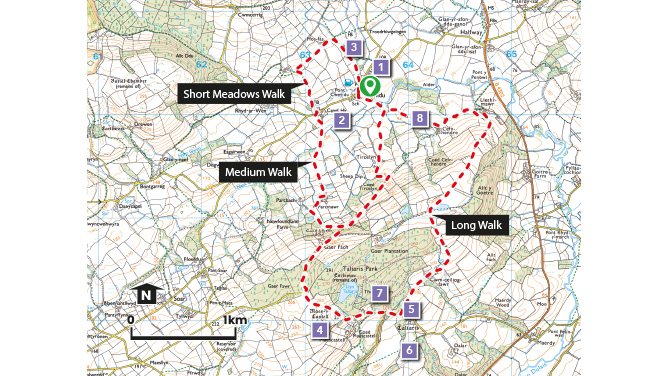Cwmdu long walk
Cwmdu
This quiet corner of Carmarthenshire has many hidden delights that make it worthy of exploration. There is evidence of prehistoric settlement here and much of the area fell within the home grange of Talley Abbey during medieval times. The impressive ruins of the abbey stand just to the north of the area covered by this leaflet.
The local landscape, dominated by the hill of Gaer Fawr and the valley of Nant Llwyd, is characterised by scattered farms and cottages, set amongst neatly hedged fields.
The area around Gaer Fawr hill was greatly influenced by the development of the Taliaris estate, which created the beautiful woodland plantations and open parkland around Taliaris mansion. Taliaris had medieval origins, but its most notable residents were the Peel family. The estate was bought in 1831 by Robert Peel, a Lancashire businessman and first cousin to Sir Robert Peel, founder of the modern police force. The Peel family owned Taliaris until 1954, and the graves of several family members can be seen at Taliaris church.
Cwmdu and Salem are the only villages in the area, each with their own pub and chapel. Picturesque Cwmdu is the older of the two. The village probably grew around the Baptist chapel built here in 1789 and has largely retained the character of a small rural 19th century village. Salem stands on land that formed the small common of Mynydd Bach, and a small cluster of cottages sprang up here after the common was enclosed in 1814. Salem chapel, which gives the village its name, was built soon afterwards.
Why Walk?
At the centre of this picturesque village is the local pub and shop which have been run by the community since the year 2000. This walk is an absolute must for any professional or budding botanist staying in the county, as the paths pass through flower rich meadows with an abundance and diverse array of wild flowers which are Sites of Special Scientific Interest.
How Long?
It is possible to enjoy a short walk lasting only an hour or so or extended walks lasting a whole day. Walks range from 2km – 7.3km
How Hard?
The short meadows walk is just over 2km (1 & 1/4 mile) and mostly over reasonably level ground.
The medium walk, immediately south of the village, is 3.7km, (2 & 1/3 miles).
The long walk from Cwmdu village taking in the hillfort and Taliaris parkland is approx. 7.3km. (4 & 1/2miles) and has lengthy hilly sections. (approx.250m or 820ft of ascent).
NB Some paths in the area may remain wet even in summer.
Starting point / Car Park - Cwmdu village
Public Transport - for up to date information visit traveline.cymru
Refreshments - ✔
Video of the walk in Cwmdu
Points of Interest
1. Providence Baptist Chapel is a fine example of a 19th century nonconformist chapel. The terraced row alongside it, which includes the post office/shop and village inn, is owned by the National Trust.
2.The farm at Capel Hir was used as a meeting house by 17th and 18th century nonconformists.
3. The short circular route to the north of the village is an absolute must for any botanist. The paths pass through flower-rich meadows that are Sites of Special Scientific Interest. These meadows have escaped the modern agricultural “improvements” of deep ploughing, re-seeding and fertilising.
The meadows are also a haven for a variety of butterflies including the chocolate brown Ringlet butterfly. NB. it is illegal to pick the flowers.
4. The well-preserved Iron Age hillfort of Maescastell is over 2,000 years old and a reminder of a time when warrior chieftains ruled Wales. The hillfort is a Scheduled Ancient Monument and has a permissive path leading up to it.
5. The foundations of Taliaris mansion are thought to be medieval its great oak staircase and the ornate plaster ceiling of the sitting room date from the early 17th century. Taliaris mansion is now a holiday complex, not open to the public.
6. In front of Taliaris mansion the footpath crosses part of the parkland designed in the 19th century to give the inhabitants of the house a pleasant view and a place to walk. The large trees in the middle of the fields were planted as ornamental features.
7. Behind Taliaris mansion are the working estate lands. The place-name of The Warren might be connected with the farming of rabbits in medieval or Tudor times. The woods here are the result of estate plantation and are enclosed by a large wall.
8. The wonderful variety of ferns, flowers, shrubs and trees growing in hedge-banks along each side of the track indicate that the hedges here are hundreds of years old. Lady Fern, Male Fern and Wild Hop thrive here along with Foxglove, Violet, and Meadowsweet flowers.

Cwmdu village

Butterfly Orchid
